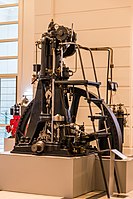
Photo from wikipedia
The present study aims to investigate the effect of swirling flow on particle deposition in a realistic human airway. A computational fluid dynamic (CFD) model was utilized for the simulation… Click to show full abstract
The present study aims to investigate the effect of swirling flow on particle deposition in a realistic human airway. A computational fluid dynamic (CFD) model was utilized for the simulation of oral inhalation and particle transport patterns, considering the k-ω turbulence model. Lagrangian particle tracking was used to track the particles' trajectories. A normal breathing condition (30 L/min) was applied, and two-micron particles were injected into the mouth, considering swirling flow to the oral inhalation airflow. Different cases were considered for releasing the particles, which evaluated the impacts of various parameters on the deposition efficiency (DE), including the swirl intensity, injection location and pattern of the particle. The work's novelty is applying several injection locations and diameters simultaneously. The results show that the swirling flow enhances the particle deposition efficiency (20-40%) versus no-swirl flow, especially in the mouth. However, releasing particles inside the mouth, or injecting them randomly with a smaller injection diameter (dinj) reduced DE in swirling flow condition, about 50 to 80%. Injecting particles inside the mouth can decrease DE by about 20%, and releasing particles with smaller dinj leads to 50% less DE in swirling flow. In conclusion, it is indicated that the airflow condition is an important parameter for a reliable drug delivery, and it is more beneficial to keep the inflow uniform and avoid swirling flow.
Journal Title: Biomechanics and modeling in mechanobiology
Year Published: 2021
Link to full text (if available)
Share on Social Media: Sign Up to like & get
recommendations!